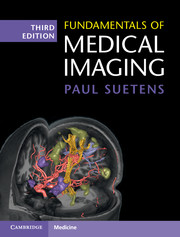Book contents
4 - Magnetic Resonance Imaging
Published online by Cambridge University Press: 13 July 2017
Summary
Introduction
Magnetic resonance imaging (MRI) is a relatively recent medical imaging modality. Although the physical phenomenon of nuclear magnetic resonance (NMR) has been known since the early 1940s, its practical application to the field of medical imaging was only realized in 1973 when Paul C. Lauterbur made the first NMR image by introducing gradients in the magnetic field. In 1974, Peter Mansfield presented the mathematical theory for fast scanning and image reconstruction, needed in clinical practice, and showed how extremely rapid imaging could be obtained by very fast gradient variations. Lauterbur and Mansfield shared the Nobel Prize in Medicine or Physiology in 2003.
A difficulty is that NMR cannot totally be explained using “classical” physics (i.e., the physical theories based on the laws of Newton and Maxwell). In 1905, Einstein demonstrated in his special theory of relativity that Newton's laws are only approximately valid. Later in the twentieth century the theory of quantum mechanics was developed to explain physical phenomena on the atomic and subatomic scale. A concise description of the basis of NMR, the property of spin angular momentum, needs the theory of quantum electrodynamics, which combines the special theory of relativity and quantum mechanics. This theory is beyond the scope of this text. A simplified discussion of NMR based on classical and quantum mechanics suffices to explain the principles of MRI.
External Magnetic Field
In essence, MRI measures a magnetic property of tissue. This section first explains the behavior of a single particle with angular momentum and magnetic moment in an external magnetic field. The problem is studied from the viewpoints of classical and quantum mechanics. Next (Section 4.2.2) the interaction of matter (such as human tissue), which contains a huge amount of particles, with an external magnetic field is discussed.
Angular Momenta and Magnetic Moments
A Qualitative Description
In classical mechanics, angular momentum is employed when discussing the rotation of an object about an axis. For example, as shown in Figure 4.1, in celestial mechanics, the description of the motion of the Earth involves two angular momenta: one corresponding to the revolution of the Earth about the Sun, and a second corresponding to its rotation about its own axis (spinning).
- Type
- Chapter
- Information
- Fundamentals of Medical Imaging , pp. 71 - 119Publisher: Cambridge University PressPrint publication year: 2017
- 1
- Cited by



